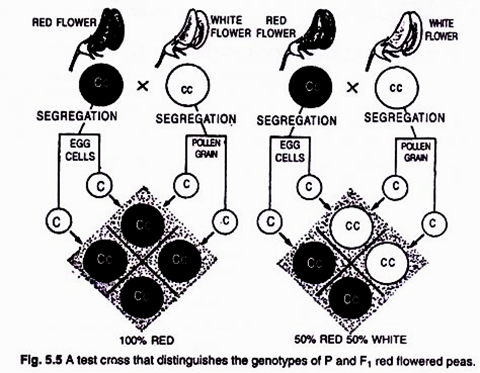The below mentioned article will highlight the two types of experiment performed by Mendel.
The two types of experiment performed by Mendel are: (1) Back Cross Experiment and (2) Test Cross Experiment.
Experiment # i. Back Cross:
When F1 individuals are crossed with one of the two parents (either CC—red flowered or cc—white flowered) from which they have been derived, then such a cross is called back cross.
In such cases there are two possibilities (Fig. 5.4):
(A) When F1 (Cc) is crossed to the parent with dominant phenotype i.e., homozygous for red colour (CC). In such a cross plants will be 100% red (Fig. 5.4-A).
(B) When F1 plant (Cc) is crossed to the parent with pure recessive (cc) white flowered plant. In such a cross 50% plants will be red flowered and 50% plants will be white flowered (Fig. 5.4-B).
Experiment # ii. Test Cross:
Test cross is the mating of a dominant phenotype (with unknown genotype CC or Cc in the above given example) to a genotype which is homozygous recessive at all the loci under consideration (Figs. 5.5 & 5.6).
The phenotypes of the offspring produced by a test cross reveal the number of different gametes formed by the parental genotype under test.
There can be two possibilities of such a cross:
(a) When impure dominant (Cc) is crossed with the pure recessive. In this cross 50% plants will be red and 50% will be white B. (Backcross is a test cross also)
(b) When pure dominant (CC) is crossed with a pure recessive (cc). In such a cross 100% plants will be red flowered.
Thus if we want to study whether the red flowered plants are homozygous or heterozygous we can take the help of a test cross.
A monohybrid test cross of heterozygous dominant with pure recessive gives a 1: 1 phenotypic ratio.
A di-hybrid test cross (of a heterozygous dominant with pure recessive) gives a phenotypic ratio of 1: 1: 1: 1 (Fig. 5.6).


